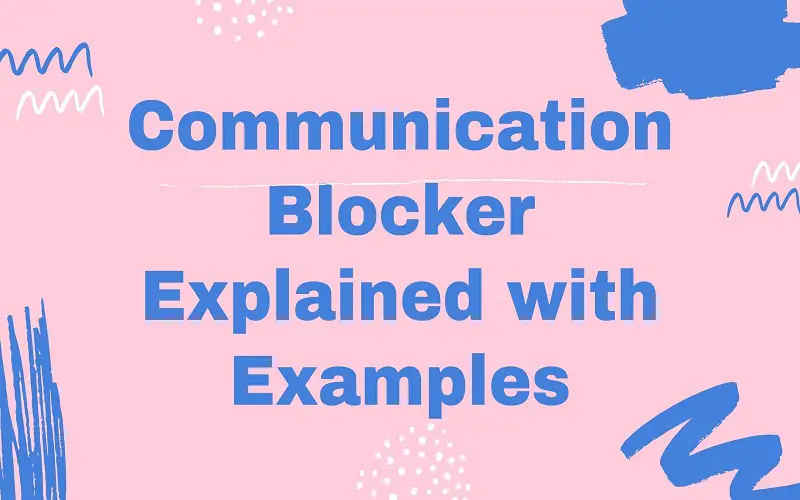Communication is one of the most important tools in project management. It ensures that information is relayed to all the team members and stakeholders for the smooth flow of activities. This explains why project managers must be good communicators.
However, it is worth noting that communication may become challenging in the life cycle of the project. Once you realize that getting messages across, be it to your audience or team members, is ineffective, you need to know why and establish ways of going at it.
In this article, we look at some of the most common reasons for ineffective communication-communication blockers. We will delve deeper into what it is, some of the examples, and conclude with how you can overcome it.
What Is a Communication Blocker?
A communication blocker is anything that hinders effective communication. It is normally someone’s action, which, even though unintentional, negatively affects the project team members, stakeholders, or even the entire project.
Therefore, as the name suggests, it is anything that ‘blocks’ or stands in the way of fruitful communication. Several communication blockers may hinder the successful relay of information during the lifecycle of a project. Let’s take a look at these.
Examples of Communication Blockers
1. False Assumptions
It is always easy to assume something about an audience. Most of the time, we believe that certain things are in the public domain and everyone must have encountered them, which turns out to be false.
For example, most people normally assume that people have background knowledge about what is being discussed by virtue of them being in the meeting and do not find it necessary to delve into the introductory part. They end up focusing on the specific issues believing that everyone is at par.
The main question that ought to be asked in such circumstances is, what happens to those who are not acquainted with the subject of discussion? Such assumptions normally result in a large chunk of the entire audience not properly understanding the relayed message, causing even bigger problems as the project progresses.
2. Stereotyping
This is one of the most significant communication blockers in organizations. A stereotype is a preformed and oversimplified idea about a person, things, or group of persons. Some are always passed to us depending on our settings.
It is normally easier to expect that a certain group of people will behave or think in a certain way based on our beliefs. We, therefore, end up communicating with a preformed idea in our minds which normally turns out to be false.
For example, we may assume that all senior management or project team members act in certain ways and carry that belief everywhere he/ she goes. However, the resultant effect is that we will not hear what those we have stereotyped have to say.
Stereotyping makes people miss cues about what the audience thinks or is trying to put across, which hinders effective communication. Some people also end up not relaying the information that the audience is interested in under the belief that they will act in a certain way.
3. Using the Wrong Communication Channel
The communication channel you choose to relay information with is important as it will determine whether your audience receives the information or not. It is impossible to communicate effectively with the wrong choice of the communication channel.
Most of the time, your message will not be noticed by the intended recipient, or worse still, he/she may forget it. For example, posting important project changes to the project portal does not guarantee that everyone will see them and act accordingly. Therefore, if you rely on the portal as your main communication channel, then chances are that it may not relay the message to everyone.
For important or pressing information, we encourage that you use push instead of pull communication. If possible, send a direct email to all the intended recipients and even follow up to check if they have received the information.
However, for instances where the information is not important or urgent, you can use pull communication instead of over-relying on push communication. You will most likely end up overloading the recipient, who will stop attending to your emails and miss important information.
Also, while still on this, it is important to note that not every piece of information should be communicated through email. Even though there are times that call for a memo or email, one cannot manage an entire project through these two avenues.
One must have face-to-face interactions with the team members, especially regarding personal corrective actions. Communication is more than words, as it also consists of non-verbal cues. At times one must read the body language of the audience to get more detailed feedback.
4. Selective Hearing
Communication is a two-way process. It involves the relaying and receiving of information. Therefore, both sides can be responsible for impaired communication, i.e., the listener and the talker. What then is selective listening? As the name suggests, it entails hearing only the parts of the message that appeals to you. Most people normally like hearing good news and pay less or no attention to bad news, which hinders communicat6ion.
A good example is during progress tracking meetings, where the stakeholders or project managers assess the project. Some people only hear about the tasks that are on track and ignore the part where the team manager talks about the project concerns.
Selective listening poses many disadvantages during the life cycle of the project as it normally poses bigger future problems.
5. Not Paying Attention to Cultural Differences
Even though a project may bring us together, we all come from different places and, therefore, have our distinct ways of life. Also, different organizations have their ways of doing things, which normally concern accountability, the quality of work, or even work hours.
Ignoring cultural differences is, therefore, a recipe for lots of communication challenges. For example, it would be absurd to assume that a contractor from another organization has the same culture as yours.
Therefore, managers are advised to be mindful of other organizations’ cultures when communicating. If faced with instances where such cultures conflict, explain to the affected parties why and how people work in their organization.
6. Mixed Messages
Sending mixed messages to the speaker can inhibit communication. Like we mentioned, effective communication requires the effort of both parties. Most people claim to have understood the relayed message but at the same time look confused, therefore pointing to the opposite. However, most speakers will tend to assume that the audience is at par with him/her.
However, in such instances, we encourage speakers to ask questions and ensure that everyone is actually at par. Such situations can also be solved by explaining everything in words.
7. Power Games
At times people engage in power games without knowing how heavily they impact and inhibit communication. This normally manifests by a party making decisions and taking action while focusing on his/ her political gain.
Whenever a person dominates a situation based on their power, he/ she forces other people to act and communicate dishonestly, which inhibits effective communication.
8. Difference in Perception
Two people can look at the same situation and see it differently. Most of the time, we see our efforts as exceptional, whereas clients or bosses feel that we could have done better. One of the reasons why this is a communication blocker is that both parties are normally right, especially in their minds.
People mostly resort to backing their perceptions, normally by picking words or behaviors of the other person in support of their view. This normally leads to selective perception as the affected parties resort to zone in on things that support their perception.
Perceptions are normally based on people’s experiences or learning, which explains why they differ most of the time. All of us can’t have the same experiences or learn the same things all through our life.
The best way to handle the difference in perception that inhibits communication is to remind ourselves that there is more than one way of looking at things. Communication calls for understanding, which means that one should try and understand the other person’s view of the situation at hand.
Strive to always arrive at a meeting of the minds.
9. Hidden Agendas
Hidden agendas are normally prevalent in business meetings. Most people come to these meetings with only one thought in mind, which is what they want. This influences their behavior, quality of their listening, and sincerity as everything is normally geared towards achieving their motive.
Such people do not pay attention to any information outside their plan. In project management, people with hidden agendas will always disparage other team members or invalidate their opinions if they suggest something that goes against or out-dos their agenda.
How then can one deal with this? The best way to get rid of this communication blocker is to find out whether you are sincere or honest when engaging in a conversation. Are your actions geared towards fulfilling your underlying motives? If yes, then the chances are that you will miss or dismiss fresh and better ideas.
Hidden agendas damage communication. Therefore, you should strive as much as possible to ensure that you are sincere and willing to accommodate other views and ideas.
10. Defensiveness
Defensiveness is one of the main hindrances to effective communication. Whenever one party in a conversation is defensive, communication breaks down. Most defensive people will not listen to everything that is being said and normally resort to adding things that were not mentioned.
This normally happens when one or both parties feel insecure. The best way of going about this is to perform a self-check before engaging in a conversation. Do not jump to conclusions and stop whenever you feel your defensive side kicking in. You are advised not to respond too quickly and first understand what the other person is saying for smooth communication.
11. Withholding of Information
Even though this may seem far-fetched, it is one of the most common communication blockers in project settings. At times team members choose to withhold information or even fail to communicate completely, especially on ‘negative’ topics such as risks and problems.
Most people, therefore, wait till the last minute, which normally turns out to be too late. Even though one may justify this by asserting that information is withheld to avoid negatively affecting the team’s morale, it messes up overall communication.
Therefore, team and project managers are encouraged to prevent such occurrences by encouraging the team members and stakeholders to communicate whenever they identify risks or potential challenges immediately.
They should ask encouraging questions, especially at the end of each meeting. A good example would be giving the team members or your audience a chance to mention some of the risks that they may have seen
How To Eliminate Communication Blockers
Communication blockers are common in our day-to-day communication. They cause the different communication issues that we face. The best way of dealing with these blockers is first to identify them and their causes.
Whenever you notice a communication issue, please think of the underlying reason and then find ways to counter it. If the problem exists in how the information is presented, you will have to use another means of presentation.
We also encourage that you engage different communication technologies in such instances as well as seek expert opinion. Remember, you may not be able to solve everything on your own and at times need external help to diagnose and solve problems.
However, always strive to apply best practices in structuring communication management in your project. This will help you identify the communication blockers and how to deal with them.
Structuring your communication well also increases the probability of effective communication and improves efficiency.
Conclusion
These are some of the most common communication blockers in our daily engagements. Ensure that you are aware of them and act accordingly, lest you inhibit your communication and miss ideas that may be life-changing.




